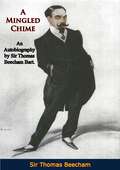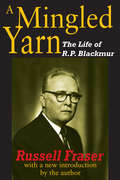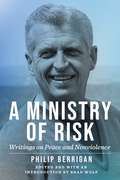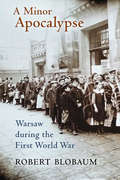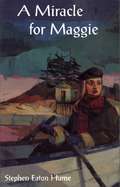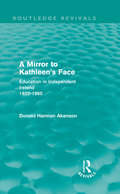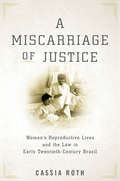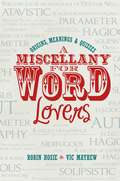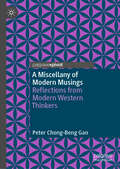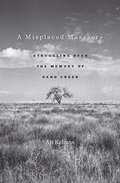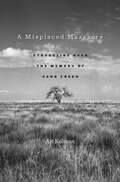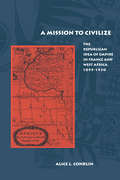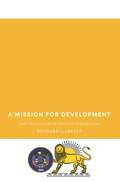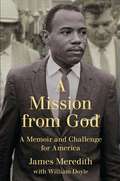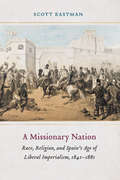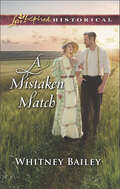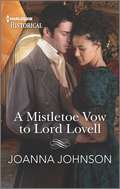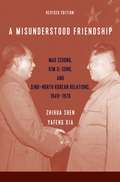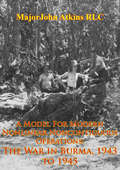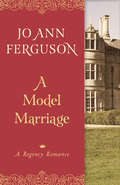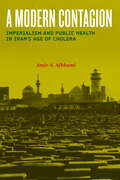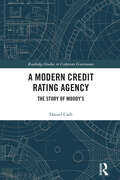- Table View
- List View
A Miner's Daughter: Home is Where the Heart is...
by Elizabeth GillFrom the bestselling author of Miss Appleby's Academy and Far From My Father's House comes a family saga perfect for fans of Nadine Dorries, Anna Jacobs and Dilly Court.When Rosalind West leaves her native Durham for a job in London with the Doxbridge Motor Company she is determined to escape her background and build a new life. London is excitingly different and tantalisingly glamorous - especially when she meets the handsome and aristocratic Freddie Harrington, a rally driver, and the son of a once-wealthy Northumberland landowner. Against her friends' better judgement Freddie and Rosalind begin a relationship. But Freddie's family have plans for him which do not include marrying a Durham miner's daughter. Turning to a close companion for consolation, Rosalind suddenly finds herself torn between two men, both of strong passions, and fierce ambition.Note: this book was previously published under the title Home to the High Fells.
A Mingled Chime: An Autobiography by Sir Thomas Beecham Bart.
by Sir Thomas BeechamThis volume is Sir Thomas Beecham's detailed memoirs of his varied and busy life as one of the world's greatest conductors. Beecham's complete lack of inhibition and his candid self-assessment are fully revealed in this very personal document.Beecham was an English conductor and impresario best known for his association with the London Philharmonic and the Royal Philharmonic orchestras. He was also closely associated with the Liverpool Philharmonic and Hallé orchestras. From the early 20th century until his death, Beecham was a major influence on the musical life of Britain and, according to the BBC, was Britain's first international conductor.Beecham's repertoire was eclectic, sometimes favouring lesser-known composers over famous ones. His specialities included composers whose works were neglected in Britain before he became their advocate, such as Delius and Berlioz. Other composers with whose music he was frequently associated were Haydn, Schubert, Sibelius and the composer he revered above all others, Mozart.
A Mingled Yarn: The Life of R.P.Blackmur
by Russell FraserR. P. Blackmur was an American critic and poet, as well as a professor of English literature and creative writing at Princeton University. At the time of his death, he had completed five books and numerous plays, poems, and short stories. He devoted most of his life to studies on Henry Adams - someone he saw in himself. In his lifetime, he received a share of adulation, but he was not successful in the way that success is commonly measured. In this work, Russell Fraser follows the course of Blackmur's self-declared failed genius. He tells the story of his precocious youth in Cambridge; his eclectic education; his years of poverty and renown as a poet, novelist, freelance music critic, and essayist; his obsessive marriage to artist Helen Dickson; his entangled friendships with T. S. Eliot, Delmore Schwartz, Allen Tate, and John Berryman; and, his passion for the wilds of Maine. He discusses Blackmur's crucial role in the literary magazines of the twenties and thirties; his unique influence as instructor of creative writing; the emotional and professional price he paid for a doubtful security at Princeton University; and, the torment of wavering between intellectual inertia and prolific inspiration. With empathy and insight, Fraser shows how the trajectory of Blackmur's career parallels the movements in the American literary scene; the experiments in poetry and fiction; the development of the New Criticism; the writer's conflict between order and anarchy, taxonomy and the full response; and, the emergence of the critic as artist. A biography, intellectual history, and literary criticism, "A Mingled Yarn" unravels Blackmur's complex character and celebrates his great achievement.
A Ministry of Risk: Writings on Peace and Nonviolence
by Philip BerriganExperience the powerful legacy of Philip Berrigan’s nonviolent resistance to war and empireFrom the battlefields of World War II to the front lines of peace activism, Philip Berrigan evolved from soldier to scholar, priest to political prisoner. Confronting the fundamental nature of America’s military-focused culture, Berrigan took an unyielding stance against societal evils—war, systemic racism, unchecked materialism, and the baleful presence of nuclear weapons. Imprisoned by his government and ostracized by his Church, Berrigan’s life is a courageous example of nonviolent resistance and liberation in the face of overwhelming odds.A Ministry of Risk is the definitive collection of Philip Berrigan’s writings. Authorized by the Berrigan family and arranged chronologically, these writings depict the transformation of one revolutionary soul while also providing a firsthand account of a nation grappling with its martial obsessions.Threading the vibrant fabric of history with autobiographical insights, introspective theology, and a clarion call to activism, A Ministry of Risk offers both a living manifesto of nonviolent resistance and a journal of spiritual reflection by one of the 20th century’s most prophetic voices.
A Minor Apocalypse: Warsaw during the First World War
by Robert BlobaumIn A Minor Apocalypse, Robert Blobaum explores the social and cultural history of Warsaw's "forgotten war" of 1914–1918. Beginning with the bank panic that accompanied the outbreak of the Great War, Blobaum guides his readers through spy scares, bombardments, mass migratory movements, and the Russian evacuation of 1915. Industrial collapse marked only the opening phase of Warsaw’s wartime economic crisis, which grew steadily worse during the German occupation. Requisitioning and strict control of supplies entering the city resulted in scarcity amid growing corruption, rapidly declining living standards, and major public health emergencies. Blobaum shows how conflicts over distribution of and access to resources led to social divisions, a sharp deterioration in Polish-Jewish relations, and general distrust in public institutions. Women’s public visibility, demands for political representation, and perceived threats to the patriarchal order during the war years sustained one arena of cultural debate. New modes of popular entertainment, including cinema, cabaret, and variety shows, created another, particularly as they challenged elite notions of propriety. Blobaum presents these themes in comparative context, not only with other major European cities during the Great War but also with Warsaw under Nazi German occupation a generation later.
A Miracle for Maggie
by Stephen Eaton HumeMaggie Davis is a young girl who lives in Chester, Nova Scotia, near Halifax, when her beloved Uncle Nick is killed by diabetes. Maggie’s father, a doctor, is greatly saddened by his brother’s death, and soon has to deal with his own daughter’s diagnosis with the dread disease. Various remedies are tried, including starvation diet popular at the time, but nothing works and Maggie’s condition worsens. Meanwhile, in Toronto, Banting and other doctors work night and day to perfect insulin. Will they succeed in time to save Maggie and thousands of others?
A Mirror to Kathleen's Face: Education in Independent Ireland 1922-60 (Routledge Revivals)
by Donald AkensonFirst published in 1975, Donald Akenson’s book was at the forefront of a radically new approach to the study of Irish educational history. Instead of investigating the evolution of the schools as an isolated process, he explores the complex interrelations of Irish education, institutions and society, treating the schools as cultural litmus paper. By presenting Ireland’s schools as a reflection of the society that produced them, Professor Akenson demonstrates that they are, in truth, "a mirror to the face of Kathleen ni Houlihan".
A Miscarriage of Justice: Women’s Reproductive Lives and the Law in Early Twentieth-Century Brazil
by Cassia RothA Miscarriage of Justice examines women's reproductive health in relation to legal and medical policy in Rio de Janeiro, Brazil. After the abolition of slavery in 1888 and the onset of republicanism in 1889, women's reproductive capabilities—their ability to conceive and raise future citizens and laborers—became critical to the expansion of the new Brazilian state. Analyzing court cases, law, medical writings, and health data, Cassia Roth argues that the state's approach to women's health in the early twentieth century focused on criminalizing fertility control without improving services or outcomes for women. Ultimately, the increasingly interventionist state fostered a culture of condemnation around poor women's reproduction that extended beyond elite discourses into the popular imagination. By tracing how legal thought and medical knowledge became cemented into law and clinical practice, how obstetricians, public health officials, and legal practitioners approached fertility control, and how women experienced and negotiated their reproductive lives, A Miscarriage of Justice provides a new way of interpreting the intertwined histories of gender, race, reproduction, and the state—and shows how these questions continue to reverberate in debates over reproductive rights and women's health in Brazil today.
A Miscellany for Word Lovers: Origins, Meanings & Quizzes
by Robin Hosie Vic MayhewMore than 100 vocabulary-building quizzes make up the core of the book, with shorter sections on: * The fascinating origins of words * Quotes and misquotes* Slang, dialects and secret languages * Unforgettable Adverts, Famous Lines from Novels and Movies* Newspeak, Basic English, spelling reform* Malapropisms, politicians' blunders and 'mispeakings'* Mnemonics and other memory joggers* Palindromes and anagrams * Semaphore. Morse, tic-tac, hand gestures and other ways of speaking without wordsEntry after entry explores the byways, oddities and curiosities of the English language.
A Miscellany of Modern Musings: Reflections from Modern Western Thinkers
by Peter Chong-Beng GanThe book starts off by giving a quick overview of the main phases within the history of philosophy in the Western tradition. It then homes in on the “modern” phase and proceeds to select key thinkers that represent that slice from the rich intellectual heritage of the West. The main chapters have these thinkers’ names as heading. The work is meant to be expository and discursive, suited to introduce the neophyte in philosophy to some of the big questions asked by philosophers and their methods of addressing these questions as well as their unique proposed answers. The coverage is selective rather than extensive; and hence, only a small portion of the philosopher’s corpus of writings will be hand-picked and considered.
A Misplaced Massacre
by Ari KelmanIn the early morning of November 29, 1864, with the fate of the Union still uncertain, part of the First Colorado and nearly all of the Third Colorado volunteer regiments, commanded by Colonel John Chivington, surprised hundreds of Cheyenne and Arapaho people camped on the banks of Sand Creek in southeastern Colorado Territory. More than 150 Native Americans were slaughtered, the vast majority of them women, children, and the elderly, making it one of the most infamous cases of state-sponsored violence in U. S. history. A Misplaced Massacre examines the ways in which generations of Americans have struggled to come to terms with the meaning of both the attack and its aftermath, most publicly at the 2007 opening of the Sand Creek Massacre National Historic Site. This site opened after a long and remarkably contentious planning process. Native Americans, Colorado ranchers, scholars, Park Service employees, and politicians alternately argued and allied with one another around the question of whether the nation’s crimes, as well as its achievements, should be memorialized. Ari Kelman unearths the stories of those who lived through the atrocity, as well as those who grappled with its troubling legacy, to reveal how the intertwined histories of the conquest and colonization of the American West and the U. S. Civil War left enduring national scars. Combining painstaking research with storytelling worthy of a novel, A Misplaced Massacre probes the intersection of history and memory, laying bare the ways differing groups of Americans come to know a shared past.
A Misplaced Massacre: Struggling over the Memory of Sand Creek
by Ari KelmanIn the early morning of November 29, 1864, with the fate of the Union still uncertain, part of the First Colorado and nearly all of the Third Colorado volunteer regiments, commanded by Colonel John Chivington, surprised hundreds of Cheyenne and Arapaho people camped on the banks of Sand Creek in southeastern Colorado Territory. More than 150 Native Americans were slaughtered, the vast majority of them women, children, and the elderly, making it one of the most infamous cases of state-sponsored violence in U.S. history. A Misplaced Massacre examines the ways in which generations of Americans have struggled to come to terms with the meaning of both the attack and its aftermath, most publicly at the 2007 opening of the Sand Creek Massacre National Historic Site.This site opened after a long and remarkably contentious planning process. Native Americans, Colorado ranchers, scholars, Park Service employees, and politicians alternately argued and allied with one another around the question of whether the nation’s crimes, as well as its achievements, should be memorialized. Ari Kelman unearths the stories of those who lived through the atrocity, as well as those who grappled with its troubling legacy, to reveal how the intertwined histories of the conquest and colonization of the American West and the U.S. Civil War left enduring national scars.Combining painstaking research with storytelling worthy of a novel, A Misplaced Massacre probes the intersection of history and memory, laying bare the ways differing groups of Americans come to know a shared past.
A Mission To Civilize
by Alice L. Conklin<P>This book addresses a central but often ignored question in the history of modern France and modern colonialism: How did the Third Republic, highly regarded for its professed democratic values, allow itself to be seduced by the insidious and persistent appeal of a “civilizing” ideology with distinct racist overtones? <P>By focusing on a particular group of colonial officials in a specific setting—the governors general of French West Africa from 1895 to 1930—the author argues that the ideal of a special civilizing mission had a decisive impact on colonial policymaking and on the evolution of modern French republicanism generally.
A Mission for Development: Utah Universities and the Point Four Program in Iran
by Richard GarlitzA Mission for Development tells the remarkable story of faculty from three Utah universities who lived and worked in Iran as part of the Point Four Program. Using the experience of these advisers, the book reexamines the rise and fall of the US-Iranian alliance and explores the roles that American universities played in international development during the Cold War. The Point Four Program sponsored American technical assistance for developing countries during the 1950s—an American Cold War strategy to cultivate friendly governments and economic development in countries purportedly susceptible to Communist influence. Between 1951 and 1964, advisers from Brigham Young University sought to modernize Iranian public education, experts from Utah State University worked to improve agricultural production, and doctors and nurses from the University of Utah helped with the Iranian government’s rural health initiatives. In A Mission for Development, author Richard Garlitz offers a critical and clear-eyed assessment of the challenges the Utahns faced and the contributions they made to Iranian development. The book also reexamines the Iranian political crisis of the early 1950s and the overthrow of Prime Minister Mohammad Mossadegh through the eyes of the Utah advisers. A Mission for Development provides rare insight into the role of these universities in international development and will be of interest to historians and policy makers.
A Mission from God: A Memoir and Challenge for America
by William Doyle James Meredith"I am not a civil rights hero. I am a warrior, and I am on a mission from God." --James Meredith James Meredith engineered two of the most epic events of the American civil rights era: the desegregation of the University of Mississippi in 1962, which helped open the doors of education to all Americans; and the March Against Fear in 1966, which helped open the floodgates of voter registration in the South. Part memoir, part manifesto, A Mission from God is James Meredith's look back at his courageous and action-packed life and his challenge to America to address the most critical issue of our day: how to educate and uplift the millions of black and white Americans who remain locked in the chains of poverty by improving our public education system. Born on a small farm in Mississippi, Meredith returned home in 1960 after nine years in the U.S. Air Force, with a master plan to shatter the system of state terror and white supremacy in America. He waged a fourteen-month legal campaign to force the state of Mississippi to honor his rights as an American citizen and admit him to the University of Mississippi. He fought the case all the way to the Supreme Court and won. Meredith endured months of death threats, daily verbal abuse, and round-the-clock protection from federal marshals and thousands of troops to became the first black graduate of the University of Mississippi in 1963. In 1966 he was shot by a sniper on the second day of his "Walk Against Fear" to inspire voter registration in Mississippi. Though Meredith never allied with traditional civil rights groups, leaders of civil rights organizations flocked to help him complete the march, one of the last great marches of the civil rights era. Decades later, Meredith says, "Now it is time for our next great mission from God. . . . You and I have a divine responsibility to transform America."
A Missionary Nation: Race, Religion, and Spain's Age of Liberal Imperialism, 1841–1881
by Scott EastmanA Missionary Nation focuses on Spain&’s crusade to resurrect its empire, beginning with the so-called War of Africa. Fought in Morocco between 1859 and 1860, the campaign involved more than forty-five thousand troops and led to a long-lasting Spanish engagement in North Africa. With popular support, the government backed French invasions of Indochina and Mexico, and many veteran soldiers from the African war were reenlisted in the brutal and protracted conflict following the reannexation of the Dominican Republic in 1861. In addition, expeditions to West Africa built a colonial presence in and around the island of Fernando Po. Few works in English have examined the impact of these nineteenth-century imperial ventures on Spanish identity, notions of race, and culture. Agents of empire—from journalists and diplomats to soldiers, spies, and clerics—took up the mantle of the &“civilizing mission&” and pushed back against those who resisted militarized occupations. In turn, a gendered, racialized rhetoric became a linchpin of Spain&’s growing involvement in North Africa and the Caribbean in the 1850s and 1860s.A Missionary Nation interrogates the legacy of Hispanic identities from multiple axes, as former colonies were annexed and others were occupied, tying together strands of European, Mediterranean, and Atlantic histories in the second age of global imperialism. It challenges the prevailing notion that secular ideologies alone informed imperial narratives in Europe. Liberal Spain attempted to reconstruct its great empire of old, but the entangled issues of nationalism, race, and religion frustrated its efforts.
A Mist of Prophecies (Roma Sub Rosa #9)
by Steven SaylorOne afternoon as Gordianus the Finder is crossing the marketplace, a beautiful young seeress staggers towards him and dies in his arms. Possibly insane, and with no memory of her past Cassandra - like her Trojan namesake - had been reputed to possess the true gift of prophecy. For such a gift there are many in Rome who would pay handsomely...or resort to murder. Cassandra had been the confidante of the rich and powerful, until she fell victim to vicious killer. Obsessed with Cassandra and her mystery, Gordianus begins to investigate. As the citizens of Rome nervously await news of the war and the political situation verges on chaos, Gordianus gradually peels away the veils of secrecy that surround Cassandra's life and death. What he uncovers has deadly implications, involving some if the most powerful women in Rome - Gordianus's pursuit of the truth not only endangers his own life, but could well affect the future of Rome herself.
A Mistaken Match
by Whitney BaileyMATRIMONY MIX-UPHoping for a fresh start, Ann Cromwell travels to New Haven, Ohio, from London, England, as a mail-order bride—and learns she’s not the wife her groom-to-be was looking for. Though handsome farmer James McCann is kindly, he’s made it clear he wants the matchmaking agency to fix their mistake. But if she can’t convince him to give her a chance, she’s not sure where she’ll go.James can’t imagine why the matchmakers ignored his request for a plain bride. He was burned by a beautiful woman before, and he’s sure someone as stunning as Ann is unsuited for rural living. While the agency sorts out the error, though, Ann quietly works her way into James’s life…but can he ever allow her into his heart?
A Mistletoe Vow to Lord Lovell: A Christmas Historical Romance Novel
by Joanna JohnsonWill their vows last a lifetime…Not just for Christmas?Abandoned by her husband, and society because her father was a slave, Honora Blake will never rely on anyone again. Until dashing Lord Lovell breaks the news that she is a widow—and penniless—and insists she spend Christmas with him and his pregnant ward. Beneath the mistletoe, passion flares between Honora and Isaac. Then childbirth places his ward’s life in jeopardy, and these strangers suddenly face marriage to protect the baby!“I was invested in His Runaway Lady throughout. A historical romance with a sweet romance at its heart.”—Rae Reads on His Runaway Lady“This book is a sensation; deeply moving, fabulously original plot with two of the most engaging characters who I can guarantee you will love from the onset.”—Chicks, Rogues and Scandals on Scandalously Wed to the Captain
A Misunderstood Friendship: Mao Zedong, Kim Il-sung, and Sino-North Korean Relations, 1949-1976: Revised Edition
by Zhihua Shen Yafeng XiaToday, the People’s Republic of China is North Korea’s only ally on the world stage, a tightly knit relationship that goes back decades. Both countries portray their partnership as one of “brotherly affection” based on shared political ideals—an alliance “as tight as lips to teeth”—even though relations have deteriorated in recent years due to China’s ascendance and North Korea’s intransigence.In A Misunderstood Friendship, leading diplomatic historians Zhihua Shen and Yafeng Xia draw on previously untapped primary source materials revealing tensions and rivalries to offer a unique account of the China–North Korea relationship. They unravel the twists and turns in high-level diplomacy between China and North Korea from the late 1940s to the death of Mao Zedong in 1976. Through unprecedented access to Chinese government documents, Soviet and Eastern European archives, and in-depth interviews with former Chinese diplomats and North Korean defectors, Shen and Xia reveal that the tensions that currently plague the alliance between the two countries have been present from the very beginning of the relationship. They significantly revise existing narratives of the Korean War, China’s postwar aid to North Korea, Kim Il-sung’s ideological and strategic thinking, North Korea’s relations with the Soviet Union, and the importance of the Sino-U.S. rapprochement, among other issues. A Misunderstood Friendship adds new depth to our understanding of one of the most secretive and significant relationships of the Cold War, with increasing relevance to international affairs today.
A Model For Modern Nonlinear Noncontiguous Operations: The War In Burma, 1943 To 1945
by Major John Atkins RLCThe War in Burma is all too frequently forgotten as a source of relevant military experience. Admittedly it did not have the strategic importance of other theatres such as the Pacific or North West Europe, but it did witness some of the hardest and most bitter fighting of the War. Because of the nature of the terrain, limited allied resources and the type of dispersed operations conducted by the enemy, Allied forces were forced to adapt a new method of warfighting to counter these difficulties. The aircraft and the radio revolutionised the way that the campaign was to be conducted. It was discovered for the first time that formations could be dispersed across the battlespace and could fight independently of a ground line of communication. The first formation to prove that this approach was possible was the 77th Brigade, later to earn the title of Chindits and commanded by Brigadier Orde Wingate. Employing Wingate's theories of Long Range Penetration for the first time, the Chindits travelled hundreds of miles behind the enemy's forward positions and attacked his rear areas and lines of communication. Throughout the operation, they received all their supply requirements from transport aircraft and were never in physical contact with friendly forces. The Chindits conducted a truly joint, mobile, nonlinear and noncontiguous operation. Within a year, conventional brigades, divisions and corps of the British Fourteenth Army and the American/Chinese forces in northern Burma were conducting similar operations, this time supported by many more aircraft for both logistic sustainment and fires. Field Marshall William Slim called it a new way of fighting and suggested that four elements contributed to the new concept: joint operations, the use of mission command, the reduction of the logistic footprint of the force to increase tempo, and the conduct of operations by dispersed forces which are tactically independent but focused on operational-level objectives.
A Model Marriage
by Jo Ann FergusonAntonia Locke longs to be slender like her pretty sister, but she is too plump for the ton. That is why she is shocked when Patrick Fairchild, the Duke of Exton, suddenly seems interested in her. She has no idea that he wants to seduce her . . . into posing au naturel for one of his paintings. No one, beyond his household, knows of his love for painting, which is hardly a proper pastime for a duke. But if he can finish this one, he will be happy. All he needs is for Antonia to pose for him, but how can he convince the proper daughter of the village's schoolmaster to agree? Marriage. He will marry her, paint her portrait, and then live separately from her once she has given him an heir. After all, many men do that, but one thing he can't imagine being in the picture--falling in love with his model--turns his plans toward a model marriage.
A Modern Contagion: Imperialism and Public Health in Iran's Age of Cholera
by Amir A. AfkhamiHow deadly cholera pandemics transformed modern Iran.Pandemic cholera reached Iran for the first of many times in 1821, assisted by Britain's territorial expansion and growing commercial pursuits. The revival of Iran's trade arteries after six decades of intermittent civil war, fractured rule, and isolation allowed the epidemic to spread inland and assume national proportions. In A Modern Contagion, Amir A. Afkhami argues that the disease had a profound influence on the development of modern Iran, steering the country's social, economic, and political currents.Drawing on archival documents from Iranian, European, and American sources, Afkhami provides a comprehensive overview of pandemic cholera in Iran from the early nineteenth century to the First World War. Linking the intensity of Iran's cholera outbreaks to the country's particular sociobiological vulnerabilities, he demonstrates that local, national, and international forces in Iran helped structure the region's susceptibility to the epidemics. He also explains how Iran's cholera outbreaks drove the adoption of new paradigms in medicine, helped transform Iranian views of government, and caused enduring institutional changes during a critical period in the country's modern development.Cholera played an important role in Iran's globalization and diplomacy, influencing everything from military engagements and boundary negotiations to Russia and Britain's imperial rivalry in the Middle East. Remedying an important deficit in the historiography of medicine, public health, and the Middle East, A Modern Contagion increases our understanding of ongoing sociopolitical challenges in Iran and the rest of the Islamic world.
A Modern Credit Rating Agency: The Story of Moody’s (Routledge Studies in Corporate Governance)
by Daniel CashThis book aims to present a picture of one of the world’s leading credit rating agencies. Credited as being the first credit rating agency, Moody’s stands as the epitome of the rating sector and all that it effects. However, outside of internal and non-public histories compiled within the rating agency itself, the story of Moody’s has never been told, until now. However, this is not a historical book. Rather, this book paints a picture of Moody’s on a wider canvas that introduces the concept of rating to you, taking into account the origins of the sector, the competitive battles that formed the modern-day oligopoly, and the characters that have each taken their turn on sculpting the industry that, today, is critical to the modern economy. The book is a story of personable people who provided the market with what it needed, but it is more than that. It is a story of conflict, impact, strategy, and most of all the relationship between big business and modern society. Standing as the gatekeeper to the capital markets that form the core of modern society, Moody’s represents the very best of what the marketplace can produce, but also the very worst. This story takes in economic crises in the antebellum US, the Panics of the early 1900s, the Wall Street Crash and the Great Depression and, of course, the Global Financial Crisis. It does this because, at the heart of each one was a member of the rating industry or the reporting industry that preceded it. Associated with almost any financial scandal you may care to remember the credit rating agencies, in their often-uncomfortable role as gatekeepers, have their fingerprints on most financial scandals and calamities. This book tells the story of the industry’s founding member.
A Modern Credit Rating Agency: The Story of Moody’s (Routledge Studies in Corporate Governance)
by Daniel CashThis book aims to present a picture of one of the world’s leading credit rating agencies. Credited as being the first credit rating agency, Moody’s stands as the epitome of the rating sector and all that it effects. However, outside of internal and non-public histories compiled within the rating agency itself, the story of Moody’s has never been told, until now. However, this is not a historical book. Rather, this book paints a picture of Moody’s on a wider canvas that introduces the concept of rating to you, taking into account the origins of the sector, the competitive battles that formed the modern-day oligopoly, and the characters that have each taken their turn on sculpting the industry that, today, is critical to the modern economy.The book is a story of personable people who provided the market with what it needed, but it is more than that. It is a story of conflict, impact, strategy, and most of all the relationship between big business and modern society. Standing as the gatekeeper to the capital markets that form the core of modern society, Moody’s represents the very best of what the marketplace can produce, but also the very worst. This story takes in economic crises in the antebellum US, the Panics of the early 1900s, the Wall Street Crash and the Great Depression and, of course, the Global Financial Crisis. It does this because, at the heart of each one was a member of the rating industry or the reporting industry that preceded it. Associated with almost any financial scandal you may care to remember the credit rating agencies, in their often-uncomfortable role as gatekeepers, have their fingerprints on most financial scandals and calamities. This book tells the story of the industry’s founding member.

